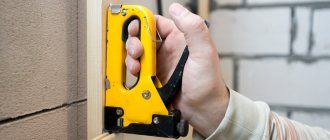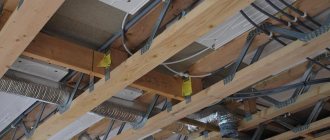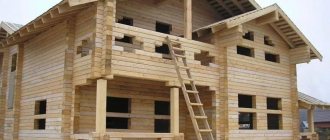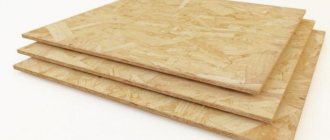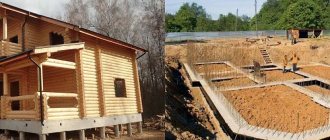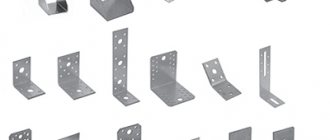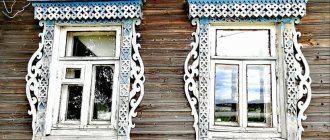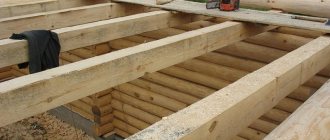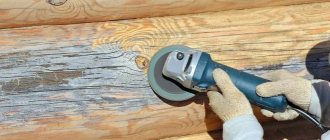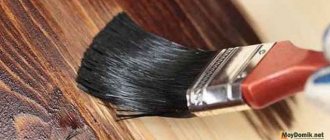Lining is one of the most popular building materials when it comes to interior cladding of walls and ceilings. Attaching it is quite simple, but this cladding will require some attention and a mandatory preparatory stage. First of all, this is a wooden sheathing for the lining, the basis for optimal fastening of the material and its long-term operation. In addition, the frame can also be used to eliminate wall defects. On the other hand, improper installation work can completely ruin the appearance of the coating, while reducing its durability and practicality. But in order not to make the mistake of “reinventing the wooden bicycle,” follow the tips and step-by-step instructions that we have collected for you in this article.
Choice: wood or metal?
Professional craftsmen consider timber to be the most popular building material for sheathing under lining. Ease of use during installation work, small “weight category” - and creating a frame with your own hands will be easier and faster. This material also has sufficient functional durability. So we choose a wooden beam.
Timber for lining
We will use standard size bars - 50 by 25, 60 by 27 millimeters. This building material is almost ideal both externally and internally. But when purchasing, make sure that there are no defects or chips on it. It is also important to know the moisture level of the wood. Recommended – 16 percent, no more.
Kinds
According to the construction method, the sheathing is of three types:
- Horizontal – for vertically oriented material sheets.
- Vertical - with horizontal fastening of the lamellas (what are the methods for fastening the lining?).
- With counter-lattice - adding an additional layer of thermal insulation under the skin for normal ventilation.
Important
The counter grille is constructed only from wooden beams.
Required: processing solutions
Do not neglect antiseptics and insecticides. This step extends the durability of the sheathing. The minimum level of treatment is a solution against fungus, rot, and mold. And insect control products should be used in houses standing on the ground - dachas, utility rooms. By the way, the cost of the compositions is not too high, and the right thing to do would be to play it safe and treat both the wooden frame and the wall with the ceiling in any room where the sheathing under the lining is being installed. The rules for using solutions are usually written on the packaging - read before you start spraying.
This is what a timber frame looks like
How to level?
It is very difficult to level the sheathing after installing the sheathing panels. It is better to set all levels along the plane of the wall in advance. But it happens that the sheathing “sinks” already during operation, for example, under the influence of moisture. In this case, it is best to disassemble the casing and replace the deformed beam. If the deformation of the wall was caused simply by a loose beam fastening, you will still have to remove the panels to re-secure the loose section.
Lathing for lining: step-by-step instructions
Preparation of the bar
The material for work should be prepared in advance. The timber should be kept for several days in the room where the finishing will be done. This will allow the building materials to acclimatize, and their temperature and humidity will become similar to that in the room.
Next, the sheathing elements are treated with an antiseptic compound (if possible and, if necessary, with an insecticide). This can be done either using ordinary brushes, processing everything in order and carefully. If the volume of work is large enough, then you can build a small trough from boards and cover it with polyethylene. We pour an antiseptic composition there and dip each of the bars. This option will provide high-quality protection against mold and mildew.
Antiseptic trough
Preparing the walls
While the timber is drying, we prepare the surface of the walls. To do this, mark the width of the racks using a pencil and using a level so that all the lines are as even as possible. Such a “drawing” will allow you to clearly see how the entire structure will subsequently look, simplifying the work and controlling the correct location of the sheathing elements.
You should also determine the starting point for installing the sheathing. It can be the lowest corner available in the room (we find it using a water or laser level). After the necessary measurements, we draw out the wall and draw a horizontal line.
Marking
Lathing with timber
How to hide wall defects
If the unevenness is significant, then it is necessary to secure the beam using special hangers, which should be positioned in a line (every half a meter) and secured perpendicularly. The prices for this type of fasteners are low, so the costs will not increase significantly. When fastening, the ends of the hangers are bent in the direction of the bar, after which it is leveled and fixed. This option is convenient due to its simplicity and accuracy: you can level surfaces quite quickly and easily.
Wooden wedges can also be used: they are the most important element for leveling significant unevenness in the surface of the walls. Prepare a certain number of wedges of different sizes in advance and treat them with antiseptics. As practice says, they tend to come in handy in most cases.
Hangers will help align the frames evenly
The installation of the sheathing under the lining is constantly monitored by level. We check the position of the bars and only then fasten them. To strengthen the angle, you can install a jumper in these places. This ensures maximum rigidity of the frame and simplifies fastening in corners.
What to consider during manufacturing?
Despite the simplicity of finishing surfaces with wooden lining, there are still several points that deserve attention:
- The size of the timber, its cross-section and shape. For reliable fastening, slats with a cross-section of 2x2 or 2x4 cm are needed. With such parameters, the guides have the necessary strength to withstand the cladding structure. The use of larger size bars will not increase the strength of the structure, but will significantly affect the cost of finishing.
- Step. The optimal distance of adjacent guides on the ceiling is 0.4 m, and on the walls - 0.5 m. With this arrangement, the optimal combination of cladding strength and its cost is achieved. Additional slats should be attached along the length of the joint, if provided.
- Method of fastening to the surface of the ceiling and walls. Unlike a metal profile, special brackets are not required to fix a wooden block to the wall. The guide is located along or across the wall with fastening with self-tapping screws or dowels.
AdviceIf there are uneven spots on the wall, and in some places the plank does not adhere tightly, then they can be filled with special pads.
What to choose - wood or metal?
The material for installation must have the following qualities:
- Resistance to aggressive moisture. If these are metal profiles, then they must be made of stainless steel, and if they are wooden, then they are coated with special impregnations.
- For internal cladding, a standard metal profile is required: it is used as a frame for drywall, and for wooden beams - a section of no more than 2x4 cm.
- The strength and durability of the cladding depends on the quality of the supporting structure. Therefore, the bars should not contain cracks or a large number of knots, and should be of an even shade.
- Cedar and larch are the most suitable species. Types other than pine lumber may be used since such wood is prone to cracking in the future as it dries.
- If the timber is treated with protective compounds, then after such a coating it must be kept indoors for at least 2 days, which will allow the material to adapt to the microclimate.
- The degree and method of drying are of great importance. Dry material that has been kept under natural conditions is best suited for the frame. However, its price is high.
Advice
To determine the degree of dryness of the wood, you need to touch the end of the lumber. If it is oozing resin or wet, you must discard the selection.
Distance between bars
To secure the lining to the wall, you need to provide a strong frame (read about how to properly secure the material here). It is necessary to calculate the optimal distance between the bars so that there is no waste of material and the strength of the coating is maximized.
To do this, it is recommended to maintain a distance of no more than 0.5 m on the walls in the horizontal, diagonal or vertical direction between the supporting elements of the sheathing. With this arrangement of the bars, the cladding will receive sufficient strength. More frequent installation of bars will lead to a loss of money and time, but the strength will practically not change.
If the guides are positioned with a step larger than 0.6-0.8 m, then the wood will have sufficient space to change its shape during operation. Often this lining swells or bends inward. Therefore, you need to adhere to the parameters recommended by the technology for installing wooden panels. The ceiling lining must be attached to the frame in increments of up to 0.4 m, since its “suspended” fastening method requires a reinforced structure.
What to choose - self-tapping screws or dowels?
The choice of specific fastening materials is based on the type of wall and its material. If the surface is made of plasterboard, metal profiles or plastered shingles, then the installation of the bars is carried out with long-length self-tapping screws.
To install the sheathing on a concrete or brick surface, the use of special dowels with casings is required, which, during the screwing process, expand and are tightly fixed in the supporting structure. This method of holding wooden blocks for these walls is more reliable.
Other tools
- A screwdriver or drill will come in handy. Since there is a huge amount of work ahead with more than a hundred dowels and screws, it is better to automate the process, reducing the time of attaching one point to a minimum.
- You will need a jigsaw or wood saw. They cut a block or cladding sheet to the required length.
- A tape measure or construction ruler will be required for accurate measurements of the parameters of the working surfaces.
- You need a plumb line, a wood pencil, a building level with an alcohol capsule. In order for the coating to be installed quickly, beautifully and durable, it is necessary to position the first cladding element very accurately relative to the horizon.
Attention
The accuracy of placing the first panel determines the quality of installation of the entire wall covering, so this operation must be performed very carefully and carefully.
Installation of insulation and waterproofing
After placing the bars, insulation material can be laid between them. It can be mineral wool, penoplex with polystyrene foam, and other variations on the theme. The thickness of the insulation varies depending on the purpose of the room itself, as well as the climatic environment. For example, in a bathhouse such indicators can reach ten centimeters (the need to ensure a minimum of heat loss).
After installing the insulation, we install a waterproofing film and protection against condensation. This is extremely necessary, for example, in the bathroom, in the steam room, or in rooms where the humidity is higher than normal. We cover the entire surface of the walls with foil, including the timber. For fastening, we use short pieces of timber, which we fasten to the sheathing with self-tapping screws.
Sheathing for lining: installation of foil
We install an additional beam (seal) in the ceiling and under the plinth. It provides maximum fit and also protects the “pie” of the walls from moisture and steam.
At this stage, installation work is considered complete. You can additionally coat it with a protective agent (varnish) and dry it.
Selection of materials
The choice of lining depends on both personal preferences and financial capabilities. It is relatively expensive, but also has a “class” quality. Definitely, it is better to buy material belonging to class “A” or “Elite”. This lining does not have any defects or knots, and immediately looks rich and famous. If you do not have a significant amount of money, you can take class “B” or even “C” material.
It is cheaper, but some of the boards may be defective. They will be used for edges, for supports, for anything, because this is a tree, and even a very construction one. Just in case, know that the best wood for lining is Siberian larch. The cladding made from it will be durable and practical, having the best technical characteristics possible.
Ceiling: lathing for lining step by step
- First of all, we install dowels: 0.8 by 4 centimeters. For installation, as a rule, you need to drill holes using a drill (depth about 5 centimeters). Next, the dowels are placed inside, and holes of the same diameter are drilled in the bars for fastenings.
- Using a cord (string), we mark the ceiling; along its perimeter, fragments of the sheathing will be placed (the interval is 50-60 centimeters).
- For evenness of installation, we use a level and fishing line (string). At least 2 people will be required to complete the work.
- The block is attached to the ceiling; if necessary, we install special plates that level the sheathing horizontally. To fix the sheathing in the ceiling surface, we use self-tapping screws.
Video: do-it-yourself ceiling installation:
As you can see, lathing under the lining is within the capabilities of everyone. It is enough to follow the simple rules given in this article, and also use high-quality material to carry out the work. And everything will probably work out!
How to attach cladding material to a frame on a wall or ceiling?
The lining is mounted vertically on the wall, horizontally on the ceiling or in a mixed version. In this case, the lining is fastened to the timber:
- nails
- screws,
- or special metal fasteners - clamps.
Attention: Nails and screws secure the boards using the through method with masking through a groove with a countersunk hole.
More details about these methods:
- With the through method, nails are driven directly through the board into the sheathing beam. At the same time, the hat remains visible, and in the heat it is noticeable, as the iron heats up.
- In the through-masking method, stainless steel pins are used rather than nails, the excess pieces of which are then sawed off. Usually after this the pins in the board are almost invisible.
- When hammering nails into the groove, the head is hidden by the next board.
- When installing boards with a hidden hole, you have to use a drill. The hole for the nail is made two-level - for the nail itself and a slightly larger one in diameter - for the head. This hole is recessed into the thickness of the board by 2-3 mm so that the head of the nail or screw is completely hidden.
- A kleimer is a metal piece that is attached to a block with a screw and holds the board in place. The next board completely hides the kleimer underneath.
Useful tips
And finally, a few tips that will ensure the reliability, durability and aesthetic appeal of wood cladding:
- Before installation, it is advisable to treat all wooden surfaces, including sheathing, with antiseptic impregnation, especially if clapboard is used to finish a wet room or external walls. This will prevent the spread of mold.
- When finishing interior spaces, materials must be kept in them for two to three days for acclimatization.
- The lined surface can be painted, coated with oil, wax, varnish, or stain. Pre-priming will reduce the consumption of varnish or paint.
Distance between bars
This parameter has already been indicated in previous paragraphs, but it is better to focus on it again. Knowing the distance between the bars will greatly simplify the installation of the cladding on the prepared surface. For reliable fixation, the step should be 40-60 cm, but no more.
Distance between hangers
There are certain subtleties in this process. The step must be selected based on the purpose of the repair. If you need to additionally place insulation, then the distance is taken slightly less than the width of the sealing material. The fact is that the insulation must adhere tightly to the ceiling in order to improve its insulating qualities.
Installation work
When wondering how to upholster a bathhouse with clapboard with your own hands, you should start by selecting the required tool.
Minimum Required
For this you will need:
- A cutting tool such as an electric saw or jigsaw;
- Mounting fasteners, including a stapler and staples for it;
- Screwdriver or screwdriver;
- An electric drill or hammer drill, if the walls are made of solid building material;
- Measuring ruler or tape measure;
- Plumb, rectangle and level;
- Hardware with which to secure the lining in the bathhouse, for example, screws or ordinary nails.
Installation of electrical equipment
Upholstery of a bathhouse with clapboard should begin only after installation of electrical wiring and equipment. Having professional knowledge and skills, this will be very easy to do; otherwise, it is advisable to contact a specialist, since unskilled work can lead to disastrous consequences.
Electrical devices in the bathhouse must be installed in accordance with fire safety regulations
Insulation finishing
Insulation is a necessary stage in the construction of a bathhouse, since it is associated with the quality of work and saving energy resources. Before deciding how to install the lining in the bathhouse, you should purchase thermal insulation materials.
In the simplest version, it can be aluminum foil mounted using brackets. Next, the insulation itself is laid in the gaps between the wooden battens of the sheathing. Upholstery of the bathhouse with clapboard begins only after installing the vapor barrier.
In the photo - vapor barrier using foil
Some hobbyists prefer to lay down the insulation first, then cover it with aluminum foil, and finish with the sheathing. One of such solutions can be seen in the photo below.
Performing lathing
When wondering how to decorate the inside of a bathhouse with clapboard, it is worth considering the need to install sheathing. Most often it is made using wooden beams. In a certain sequence, the planks are attached to the wall, for which dowels or screws are used.
Installation with nails
The installation process will not be complete without drilling. If the walls have a wooden base, then, as the instructions say, the sheathing can be installed using nails. In both the first and second cases, it is extremely necessary to treat the wood with an antiseptic composition.
Installation of lining
Let's find out how to properly upholster a bathhouse with clapboard. Let's just say one thing: this approach adds excessive beauty, simplicity and benefits.
Dressing room lining
The following minimum rules should be followed:
- Trimming of the lining is carried out only after an accurate measurement of the ceiling height. The panels are fixed along the area of the lock and from the side of the heating element or corner;
- Installation of the lining is done sequentially along the entire perimeter of the internal space of the bathhouse. The last fragment of the panel is trimmed;
- Slopes are made in the same way as with a metal analogue.
Remember that wood is very sensitive to changes in temperature conditions, so before use it is better to let it sit in the room where installation work will be carried out. One day is enough for the lining to acquire the required humidity and temperature. If lining made of cedar or other exotic trees is used in the finishing, the acclimatization time will be different.
When installing the lining, as well as when carrying out paint and varnish work, you should be guided by fire safety rules in order to prevent accidental fire of the structure.
Final work
After fixing the lining, in order to increase its durability, practicality and reliability, antiseptic treatment and impregnation should be performed. Some experts insist on additional coating with special-purpose paints.
Here is one example of how this can happen in practice.
Russian bath
There are three types of baths in Russia, these are:
- Black bath;
- White bath;
- Camping sauna.
The first one is heated using birch firewood, which perfectly disinfects the air inside. After burning, be sure to ventilate the room from smoke and wash off the soot. The black bath has antiparasitic properties. Made from hardwood and softwood logs.
The next steam room is built from various materials (brick or stone). The stove can be made of stone or other rocks. The white bathhouse has a separate water tank, which is very convenient. Modern baths were built according to this type.
The camp sauna is popular among tourists. Constructed from branches and covered with polyethylene. Stones are placed inside and a fire is lit under them. It takes a long time to heat such a steam room, and the accumulated soot on the surface of the cellophane is very disturbing. It can get dirty.
Having listed the types of steam rooms, it is worth noting that most steam rooms in them are finished inside and outside with clapboard, since wood is the most convenient and natural in using a sauna. Whether to install eurolining or a cheaper option depends on the size of your funds.

